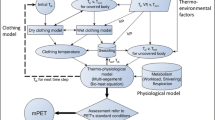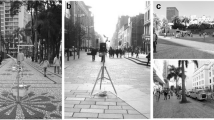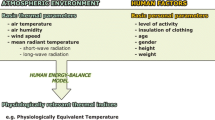Abstract
Physiologically equivalent temperature (PET) is a thermal index that is widely used in the field of human biometeorology and urban bioclimate. However, it has several limitations, including its poor ability to predict thermo-physiological parameters and its weak response to both clothing insulation and humid conditions. A modified PET (mPET) was therefore developed to address these shortcomings. To determine whether the application of mPET in hot-humid regions is more appropriate than the PET, an analysis of a thermal comfort survey database, containing 2071 questionnaires collected from participants in hot-humid Taiwan, was conducted. The results indicate that the thermal comfort range is similar (26–30 °C) when the mPET and PET are applied as thermal indices to the database. The sensitivity test for vapor pressure and clothing insulation also show that the mPET responds well to the behavior and perceptions of local people in a subtropical climate.
Similar content being viewed by others

Avoid common mistakes on your manuscript.
1 Introduction
The physiologically equivalent temperature (PET) is a thermal index widely used in the field of human biometeorology and is based on the energy balance of the human body (Höppe 1999). This index is recommended in VDI Guideline 3787 (German Engineering Society) for the evaluation of human thermal comfort in outdoor environments (VDI 1998). PET enables a person to compare the integral effects of complex thermal conditions outdoors with their experience indoors.
However, PET has several limitations: (i) the physiological mechanism of the two-node Munich Energy-balance Model for Individuals (MEMI) model is over 30 years old and is therefore out of date, (ii) clothing mechanism has a weak influence due to the one-node model, and (iii) PET underestimates the influence of vapor pressure in warm and humid regions. Chen and Matzarakis (2017) addressed these limitations in several ways: (i) by applying a bio-heat equation and multi-segment body model (16–26 nodes) to improve the thermo-physiological and thermoregulation of PET, (ii) by using multi-layer clothing based on total clothing insulation, (iii) by modifying the mechanism used to transfer latent heat fluxes from the skin and clothing to air, and (iv) by developing the modified PET (mPET) to adapt to climatic conditions, particularly those of hot and humid regions (Lin 2009; Kántor and Unger 2011; Lin et al. 2015; Chen and Matzarakis 2017).
This study is the first step toward validating the application of mPET in hot and humid regions. It will be compared to the PET using a thermal comfort survey database comprising questionnaires collected from participants in hot and humid Taiwan. The objectives of the study were as follows:
-
1)
To understand the characteristics of PET and mPET in relation to thermal comfort in hot and humid regions
-
2)
To define the neutral temperature and thermal comfort range of both PET and mPET
-
3)
To explore the sensitivity of vapor pressure and clothing insulation on both PET and mPET
2 Method
This study was based on an outdoor thermal comfort database derived from weather perception and preference survey projects conducted in hot and humid Taiwan. The database consists of participants’ personal demographic information and their perceptions of the thermal environment and microclimatic conditions to which they were exposed. A total of 2071 questionnaires were collected during the period from 2011 to 2014. More detailed information about the survey can be found in Lin et al.’s study (2015).
Neutral temperature (Tn) represents the optimal comfortable temperature in which participants feel neither too hot nor too cold (Fanger 1972). To compare the Tn values for PET and mPET, the thermal sensation vote (TSV, which comprises a seven-point scale ranging from − 3 = cold, 0 = neutral, to 3 = hot) for every 1 °C PET and mPET, was identified. The mean TSV (MTSV) of the participants was then calculated, and the corresponding PET and mPET scatter plot was drawn and fitted with linear regression. The Tn is the PET and mPET value where MTSV = 0 intersects the regression line. Detailed explanations of Tn are provided in several previous research studies (de Dear and Fountain 1994; Lin and Matzarakis 2008; Lin 2009; Lin et al. 2015).
3 Results
3.1 Distribution of PET and mPET
Figure 1a shows the distribution of PET versus mPET values for 2071 subjects in the database. The mPET fits PET well with R2 = 0.99; furthermore, PET and mPET have identical values at 31.2 °C. Above 31.2 °C, mPET is slightly lower than PET as the slope of the regression line = 0.9.
As Fig. 1b shows, the values of mPET and PET in the comfort zone of 26–30 °C in Taiwan (Lin and Matzarakis 2008; Lin et al. 2015) are similar. This indicates that mPET has moderate values for very cold and very hot conditions and thus adapts well to hot and humid regions.
3.2 Thermal comfort range of PET and mPET
The MTSV of the participants and the corresponding PET and mPET scatter plots are shown in Fig. 1b. The correlation coefficients for PET and mPET are high (R2 = 0.95), and the Tn is equal (28.3 °C mPET). Furthermore, PET and mPET have a similar comfort range (MTSV = − 0.5 to + 0.5) of between 25 and 31 °C. The slope of the regression model for mPET (0.198) indicates it has higher sensitivity to MTSV compared with PET (slope = 0.172).
3.3 Sensitivity of vapor pressure and clothing insulation on PET and mPET
To explore the sensitivity of vapor pressure on PET and mPET, participants exposed to a thermal comfort range only (26–30 °C) were selected. These were then categorized according to the vapor pressure group (each set of 2 hPa), and an analysis was then conducted on whether participants’ mean humidity sensation vote (MHSV comprises a 7-level scale ranging from − 3 = very dry, 0 = neutral, to 3 = very wet) was related to different vapor pressure conditions. As Fig. 2a shows, the correlation between MHSV and vapor pressure for the mPET group (R2 = 0.82) was higher than that of the PET groups (R2 = 0.71). This indicates that the mPET reacts better to vapor pressure.
The correlations between clothing and thermal index values for PET and mPET were then plotted, as shown in Fig. 2b. The results show that the correlation between clothing insulation and mPET (R2 = 0.86) was higher than that of clothing insulation and PET (R2 = 0.79). This indicates that mPET reacts better to clothing mechanism (Chen 2016; Chen and Matzarakis 2017).
4 Discussion and conclusions
PET is one of the thermal indices that have been widely applied outdoors for the evaluation of human biometeorology; however, it has disadvantages, particularly when applied in hot and humid regions (Chen and Matzarakis 2017). The mPET was developed to address these issues and was evaluated in this study through a thermal comfort survey database obtained from participants in hot and humid Taiwan. As shown in Fig.1b, the results indicate that the mPET reached the MTSV for very cold and hot conditions and therefore adapted favorably to hot and humid regions. Moreover, mPET was also more sensitive to vapor pressure and clothing insulation, indicating that it adapts better in hot and humid regions and to human behavior in different climates.
Several studies have applied the original PET, using a thermal comfort survey, as a thermal index to quantify thermal comfort classifications and thermal parameters in several countries, including Italy (Salata et al. 2016), Portugal (Oliveira and Andrade 2007), Israel (Cohen et al. 2013), Taiwan (Lin and Matzarakis 2008; Lin et al. 2015), Egypt (Mahmoud 2011), China (Zeng and Dong 2015), and Syria (Yahia and Johansson 2013). In this study, the results indicate that the neutral temperature and thermal comfort range are generally the same (26–30 °C), irrespective of whether the thermal comfort database is generated by PET or mPET to calculate thermal indices. Therefore, the previous PET thermal comfort classification conducted in various countries and climates can be applied in the thermal environment presented by the mPET.
In terms of the importance of the study, this database consisted of 2071 respondents (Lin et al. 2015) who were interviewed in an outdoor environment or semi-outdoor space in Taiwan where the thermal environment was also measured. The surveys were conducted for four seasons in northern, central, and southern Taiwan. This shows that the database fully reflects the results of mPET when applied to MTSV.
Compared with the original PET, the results revealed that mPET is more sensitive to humidity and can thus explain participants’ subjective perception of humidity. This indicates that it is more appropriate to apply mPET than PET in hot and humid regions.
References
Chen Y-C, Matzarakis A (2017) Modified physiologically equivalent temperature—basics and applications for western European climate. Theor Appl Climatol. https://doi.org/10.1007/s00704-017-2158-x
Chen YC (2016) Modification and adjustment of physiologically equivalent temperature for universal applications. PhD Thesis, Albert-Ludwigs-Universität Freiburg im Breisgau
Cohen P, Potchter O, Matzarakis A (2013) Human thermal perception of Coastal Mediterranean outdoor urban environments. Appl Geogr 37:1–10
de Dear RJ, Fountain ME (1994) Field experiments on occupant comfort and office thermal environments in a hot-humid climate. ASHRAE Trans 100:457–474
Fanger PO (1972) Thermal comfort. McGraw Hill, New York
Höppe P (1999) The physiological equivalent temperature—a universal index for the biometeorological assessment of the thermal environment. Int J Biometeorol 43:71–75
Kántor N, Unger J (2011) The most problematic variable in the course of human-biometeorological comfort assessment—the mean radiant temperature. centeurjgeo 3:90–100
Lin T-P, Yang S-R, Matzarakis A (2015) Customized rating assessment of climate suitability (CRACS): climate satisfaction evaluation based on subjective perception. Int J Biometeorol 59:1825–1837
Lin TP (2009) Thermal perception, adaptation and attendance in a public square in hot and humid regions. Build Environ 44:2017–2026
Lin TP, Matzarakis A (2008) Tourism climate and thermal comfort in Sun Moon Lake, Taiwan. Int J Biometeorol 52:281–290
Mahmoud AHA (2011) Analysis of the microclimatic and human comfort conditions in an urban park in hot and arid regions. Build Environ 46:2641–2656
Oliveira S, Andrade H (2007) An initial assessment of the bioclimatic comfort in an outdoor public space in Lisbon. Int J Biometeorol 52:69–84
Salata F, Golasi I, de Lieto Vollaro R, de Lieto Vollaro A (2016) Outdoor thermal comfort in the Mediterranean area. A transversal study in Rome, Italy. Build Environ 96:46–61
VDI (1998) Methods for the human biometeorological evaluation of climate and air quality for the urban and regional planning. Part I: Climate. VDI guideline 3787. Part 2. Beuth, Berlin
Yahia MW, Johansson E (2013) Evaluating the behaviour of different thermal indices by investigating various outdoor urban environments in the hot dry city of Damascus, Syria. Int J Biometeorol 57:615–630
Zeng Y, Dong L (2015) Thermal human biometeorological conditions and subjective thermal sensation in pedestrian streets in Chengdu, China. Int J Biometeorol 59:99–108
Author information
Authors and Affiliations
Corresponding author
Rights and permissions
About this article
Cite this article
Lin, TP., Yang, SR., Chen, YC. et al. The potential of a modified physiologically equivalent temperature (mPET) based on local thermal comfort perception in hot and humid regions. Theor Appl Climatol 135, 873–876 (2019). https://doi.org/10.1007/s00704-018-2419-3
Received:
Accepted:
Published:
Issue Date:
DOI: https://doi.org/10.1007/s00704-018-2419-3





